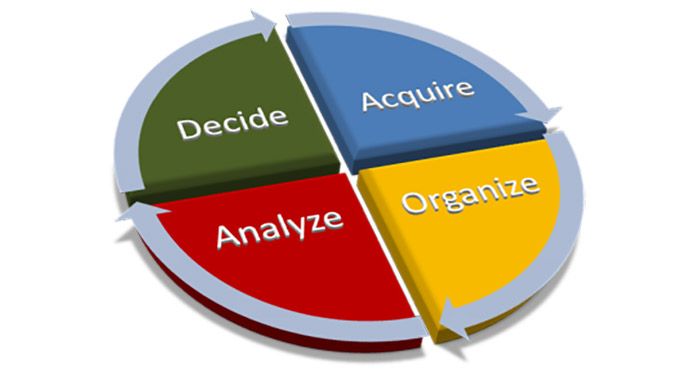Are Big Data Risks Costing Money?
Views, News & more

With all the Big Data that’s available for companies to mine and analyse, you probably think that there is a lot of risk involved. Privacy issues, concerns over security and basic human error can all play a part when analysing huge datasets. And you’d be right — Big Data does come with the risks mentioned here, but there are many ways in which you can combat them. Let’s take a look.
Now for absolute privacy, I’m just going to need your credit card, your social security number, and your mum’s maiden name…
One leading concern among businesses thinking about utilising Big Data is the privacy of customer data. Consumers are rightly concerned about how their personal data is used, how it’s kept secure and just who exactly has eyes on it. Organisations, therefore, have to ensure that the information they are collecting isn’t going to be leaked or misused in any way, shape or form.
In fact, such is the concern over data privacy that companies that fail to follow strict data protection laws can potentially land themselves with very expensive lawsuits and, depending on the extent of the breach, can even lead to people being put in prison. A good example of this is the lawsuit Morrisons was facing from its employees over a data breach late last year, after payroll data was leaked from within the company, leading to a former employee being imprisoned, and then published on the internet. Therefore, companies need to insure that they store the data appropriately and safely, and keep up to date with changes to the law.
I assure you, your data is quite secure in this unsecured server
Another issue is the growing concern over the potential for cybercriminals to hack into and steal data. The number of reported data breaches has increased over recent years, from 136 reported cases in 2005, to well over 2,100 data breaches reported in 2015, according to a Verizon report. These attacks are getting more costly and are extremely damaging to companies in terms of negative publicity.
For example, two high profile cases was the hacking of LinkedIn, where more than 100 million accounts and personal details were taken, and the TalkTalk hack, where the details from 157,000 people were stolen. These hacks affected consumer confidence in both of the companies. Regarding the TalkTalk hack, over 101,000 customers left the company as a direct loss of confidence in the company.
In fact, it’s becoming more of a trend, as five of the top six data thefts of all time have been over the past two years. In 2014, American Home Retailer Home Depot was breached, affecting 56 million credit and debit cards. This amounted to approximately $837.2 million in costs. Also in 2014, a cyber attack affected JP Morgan Chase and 83 million household and business accounts. This attack allegedly impacted two-thirds of all American households. The hackers made at least $100 million dollars in this attack. Sony was also hacked in 2014, where hackers used hacked employee details to steal over 100 terabytes of data, of which the monetary damages were well in excess of $100 million. Ebay, suffered the same mislaying of employee log in details to have 145 million user account details compromised in February 2014. And who can forget the attack that Target suffered, which gave cybercriminals over 40 million credit and debit card details? All these attacks add to concern as to how data is protected or if it can be.
Obviously, the companies we’re talking about here are huge. But it’s a sad fact that the larger the company, the more likely it will be targeted by criminals. So it’s imperative companies keep their data secure and that they update their technology when told to do so by the providers.
With Big Data comes great costs
Of course, the costs of going the Big Data way are another factor for companies to consider too. Collecting all that data, analysing it, storing it.using it to report trends and figures and complying to data laws… all add up. And if there are breaches, costs have to be factored in for that as well.
However, companies can negate the costs by actually designing a strategy of what they will be using the data for before actually starting to use it. As with all strategies, starting with what you wish to achieve is essential. From them you can draw efficient budgeting and planning by setting out the actual resources needed for your project. Is this the correct data for the project? How much data storage will I need? What analytics will I be using? ,.. are all questions that need to be answered before launching yourself in data mining. ‘The most effective approach to building a model usually starts, not with the data, but with identifying a business opportunity’, says that McKinsey report.
I pressed the red button and voila, data is unprotected
Human error happens. But it can be particularly painful when companies look at the data and get the trends, well, just plain wrong. Trends are great for making predictions on the future of a given market, but they also have a way of triggering knee-jerk reactions, when the trends may only be a temporary phenomenon.
For example, when a company looks back on data and detects a large amount of sales over a single week, they may believe that it will happen again. However, the circumstances over those increased sales could be over an event that happened, such as a sporting event or concert.
To combat the misreading of data, companies have to insure they look at the full picture and are not blinded by any spikes seen in the data. Best practices such as mining the right data, not skewing the data to the company’s favour, must be carried out when analysing the data, otherwise companies could follow a path they, in hindsight, wouldn’t have gone down.
Srikanth Velamakanni, founder and CEO of Fractal Analytic, said "If you don't do analytics in the right manner, you can come up with some very wrong conclusions. I've seen so many examples — tons and tons of examples where companies make those mistakes." And he gives a very good example of misinterpreting the data here.
Find me the correlation with summer and ice cream sales
Finally, collecting bad data is not healthy for businesses either. Simply put, some companies that do not have a strategy regarding the data they collect, often just collect as much data as possible and then analyse it later. Not only is this a waste of storage capacity (at a high cost, we might add) but it also means that a lot of the data is irrelevant and, furthermore, quickly outdated. In today’s mostly digital world, it’s easy to collect the data, but actually collecting the right data to draw the right conclusions is more difficult. You can’t go around just collecting everything. More data doesn’t mean it’s particularly better data. Companies dealing with large amounts of data need to have, like we’ve been saying throughout this blog, a plan and a strategy. They must decide whether collecting Big Data is indeed a requirement for them and, if so, how they are going to use it to make business decisions. Which, what a coincidence, is the focus of our next blog: How to use Big Data to make informed decisions.
Get in touch
020 7847 4510
We may process your personal information in order to send you information you request, measure and improve our marketing campaigns, and further our legitimate interests. For further details, see our privacy policy.
Contact us
-
- Head Office:
- hSo, 50 Leman Street, London, E1 8HQ
- Switchboard:
- 020 7847 4500
- Support (24x7):
- 0333 200 3337
- support@hso.co.uk
- Marketing & Sales:
- 020 7847 4510
- info@hso.co.uk

















